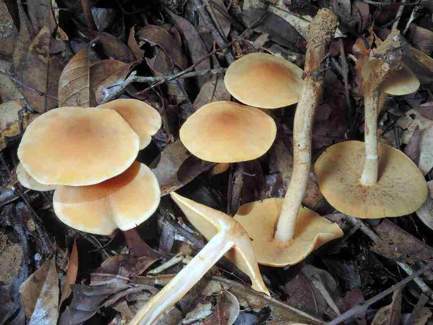 Hebeloma angustilamellatum (Photo: T. Læssøe)
Hebeloma angustilamellatum (Photo: T. Læssøe)Taxonomy
Full name: Hebeloma angustilamellatum (Zhu L. Yang & Z.W. Ge) B.J. Rees & Orlovich, Mycologia 105 (4): 1055 (2013)Genus: Hebeloma
Section: Porphyrospora
Basionym:
Anamika angustilamellata Zhu L. Yang & Z.W. Ge, Mycol. Res. 109 (11): 1261 (2005)
Types: CHINA: Yunnan: Geduo, Yingjiang County (approx. 24.7052°N, 97.932°E, alt. approx. 850 m a.s.l.) in subtropical woodland under Castanopsis sp., Dipterocarpus sp. and Lithocarpus sp., 18 Aug. 2003, Z.L. Yang (Holotype. herbarium acc. no. KUN F0080950, HKAS 42927, HJB1000408).
- arrow_drop_downarrow_drop_upEtymology
- arrow_drop_downarrow_drop_upOriginal diagnosisPileus 3–10 cm diametro, primo hemisphaericus vel conicoconvexus, brunneus vel luteo-brunneus, dein convexus vel plano-convexus, rugulosus, luteolus vel cremeus, saepe disco brunneo, reliquiis volvae coactis, flocculosis, albidis, glabrescentibus ornatus. Lamellae adnatae vel subdecurrentes, confertae, angustae, primo albidae, dein flavidae, flavae vel pallide aurantiacae, postremo brunneae, lamellulis vulgaribus. Stipes 5–12 x 0.5–1.5 cm, subcylindricus vel sursum attenuatus, primo albidus, cremeus vel flavidus, dein albidus vel griseolus, annulatus. Annulus minutulus, albidus, cremeus vel flavidus, superior, evanescens. Caro alba vel albida, amarella. Basidia subcylindrica, medio constricta, 4-sporigera. Basidiosporae in cumulo brunneae, (9.0–)9.5–11.0(–12.5) x (6.5–)7.0–8.5(–9.5) μm, amygdaliformes vel limoniformes, verrucosae, poris germinativis absentibus. Pleurocystidia versiformia vel subfusiformia, saepe mucronata vel rostrata. Cheilocystidia subcylindrica vel angusticlavata. Pileipellis ex epicute ex hyphis repentibus, cylindraceis et hypocute e hyphis inflatis, subcellularibus composita. Fibulae praesentes.
- arrow_drop_downarrow_drop_upEnglish translationPileus 3-10 mm in diameter, at first hemispherical or conical-convex, brown or yellow-brown, then convex or plano-convex, wrinkled, yellowish or creamy, often brown on the disc, decorated with floccose, whitish aggregates of velar remnants, tending to become glabrous. Lamellae adnate or subdecurrent, crowded, narrow, at first whitish, then yellowish, yellow or pale orange, finally brown, lamellulae common. Stipe 5-12 x 0.5-1.5 cm, subcylindrical or attenuate upwards, at first whitish, cream or yellowish, then whitish or greyish, annulate. Annulus very small, whitish, cream or yellowish, superior, vanishing. Context white, bitterish. Basidia subcylindrical, constricted in the middle, four-spored. Basidiospores brown in mass, (9.0-) 9.5-11.0 (-12.5) x (6.5) 7.0-8.5 (-9.5) μm, amygdaliform or citriform, roughened, germ pore absent. Pleurocystidia versiform or subfusiform, often mucronate or rostrate. Cheilocystidia subcylyndrical or narrowly clavate. Pileipellis constituted by an epicutis of repent, cylindraceous hyphae and a subcutis of swollen subcellular hyphae. Clamps present.
References
Description
- arrow_drop_downarrow_drop_upThresholds
Description of Hebeloma angustilamellatum based on 7 collections
- arrow_drop_downarrow_drop_upMacroscopic descriptionPileus: (20) 27–63 (100) mm diameter; shape convex, often broadly umbonate; characters often remains of universal veil or rugulose; margin characters involute; viscosity tacky when moist; colour variation often unicolour or two color; colour at centre often yellowish brown, occasionally brownish olive or umber.
Lamellae: attachment decurrent tooth, often adnate; maximum depth up to 3 mm; number of complete lamellae 90–114; presence of tears absent; white fimbriate edge often absent or weak.
Cortina presence: often yes, occasionally no.
Stipe: (40) 50–83 (120) x (5) 6–9 (15) {median} x (5) 9 (13) {basal} mm; stipe Q 6.7–10.0; base shape clavate, often cylindrical; floccosity fibrillose, often floccose or pruinose at apex; rooting no; thick rhizoids at base absent;
Context: Texture firm; stipe interior stuffed; stipe flesh discolouring variable; slenderness measure 13.1–14.7; smell occasionally odourless; taste weakly bitter where recorded.
Spore deposit colour: fawn.
Exsiccata characters: Not recorded.
- arrow_drop_downarrow_drop_upMicroscopic descriptionSpores: shape amygdaloid or limoniform; colour in microscope brown; guttules no. papilla often yes, occasionally very strongly; Spore Code: (O2) O3; (P1) P2 P3; D3.
Basidia: (18) 19–29 x 6–9 μm; ave. Q 3.1–3.4; spore arrangement 4 spored;
Cheilocystidia: main shape often cylindrical, napiform or turbinate, occasionally clavate; special features observed often mucronate or short, occasionally many collapsed in exsiccata or rostrate; cheilocystidia ratios: A/M = 0.73–0.94; A/B = 0.93–1.25; B/M = 0.67–0.83.
Pleurocystidia: seen.
Ixocutis: epicutis thickness (measured from exsiccata) not recorded; ixocutis hyphae width not recorded; ixocutis hyphae encrustation Not recorded; shape of trama elements beneath subcutis Not recorded.
Caulocystidia: Similar to cheilocystidia but larger, up to 70 μm.
- arrow_drop_downarrow_drop_upSpore measurements
- arrow_drop_downarrow_drop_upCheilocystidia measurements
- arrow_drop_downarrow_drop_upHabitat and distributionWhere only one possible associate was recorded, the most commonly recorded associate was Lithocarpus (50.0%) but Fagaceae (50.0%) were also recorded. In these cases the most commonly recorded family was Fagaceae (100.0%). We have additional records where Castanopsis (33.3%) and Dipterocarpus (33.3%) were recorded as possible associates, but in these cases a number of possible associates were mentioned. Overall the most commonly recorded families are Fagaceae (100.0%) and Dipterocarpaceae (33.3%) The growth habit of our collections was often scattered or solitary and occasionally caespitose or gregarious.
According to our current data, the species is found on multiple continents with collections found in Temperate Asia (57.1%) and Tropical Asia (42.9%). On these continents, collections have been found only in the tropical & subtropical moist broadleaf forests WWF biome The World Wildlife Fund (WWF) have divided the world into 867 terrestrial ecoregions. The ecoregion here is estimated by mapping from the GPS coordinates of the collection using data made available by Dinerstein et al (2017). Use this webtool to explore the ecoregions visually or see a full list of current ecoregions on Wikipedia. (Northern Indochina subtropical forests (57.1%), Luang Prabang montane rain forests (28.6%) and Kayah-Karen montane rain forests (14.3%) ecoregions). From collector information, it appears collections have been found in the 1.5 Forest – Subtropical/tropical dry (57.1%) and 1.9 Forest – Subtropical/tropical moist montane (42.9%) IUCN habitats We map from the collector's description of the habitat to the International Union for Conservation of Nature (IUCN)'s definition using a standardised set of rules. Please see this page for a full list of IUCN habitats..
Within Temperate Asia all our records are from China (Yunnan).
Within Tropical Asia all our records are from Indo-china (Laos and Thailand).
Geographic distribution
Phenology
- arrow_drop_downarrow_drop_upAdditional cited collections